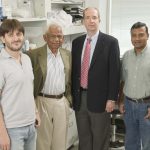5th Anniversary of the V Foundation for Cancer Research Boo-Yah Raises Over $3.1 Million for Disparities in Cancer Research
Read moreType: Translational
Facilitate the transition of projects from the laboratory to the clinic. Translational researchers seek to apply basic knowledge of cancer and bring the benefits of the new basic-level understandings to patients more quickly and efficiently. These grants are $600,000, three-year commitments
Nancy Lin, M.D., Kornelia Polyak, M.D., Ph.D.
Christopher E. Touloukian, M.D.
Funded by The V Foundation Wine Celebration Vintner Grant
Raju Chaganti, Ph.D., Robert Motzer, M.D.
Derek C. Radisky, Ph.D., Lynn Hartmann, M.D.
Ignacio I. Wistuba, M.D., Edward Kim, M.D.
Hal Broxmeyer, Ph.D., Sherif S. Farag, M.D., Ph.D., David Jones, Ph.D.
Stephen Gottschalk, M.D., Nabil Ahmed, M.D., M.P.H, Lisa Lynn Wang, M.D.
William Pao, M.D., Ph.D., David Weaver, Ph.D., Alex Waterson, Ph.D.









